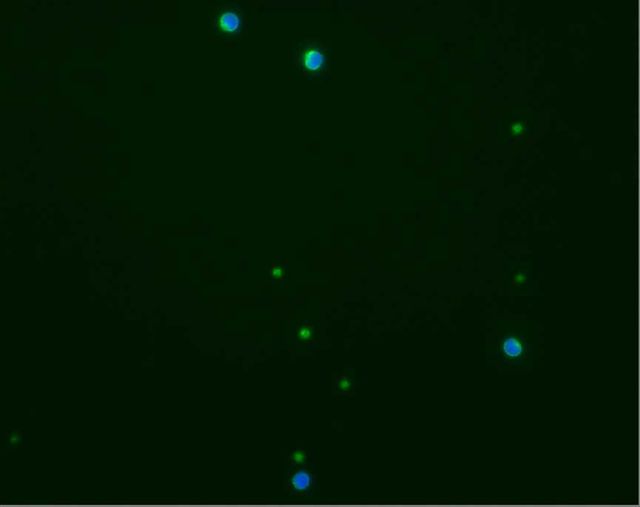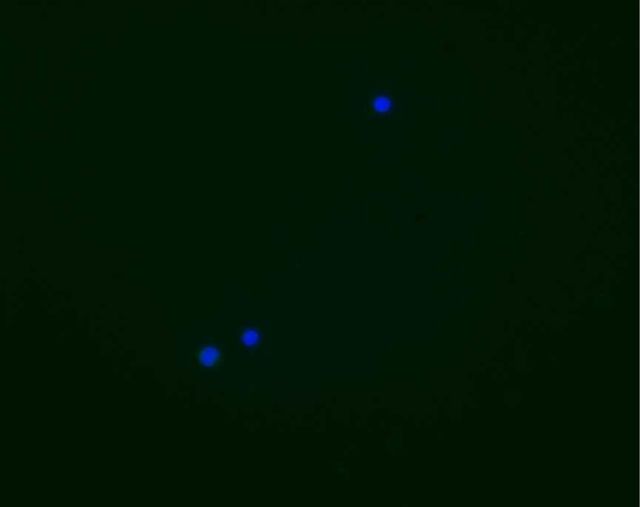Cite this page: Pernick N. CD49. PathologyOutlines.com website. https://www.pathologyoutlines.com/topic/cdmarkerscd49a.html. Accessed April 23rd, 2024.
CD49a
Definition / general
- Integrin alpha 1 chain, which combines with beta1 subunit (CD29) to form a receptor for collagen and laminin
- Also called very late antigen (VLA) alpha 1 chain, integrin alpha 1 chain and ITGA1
- Mesenchymal stem cells are selected from bone marrow by CD49+ with flow cytometry (Br J Haematol 2003;122:506, J Mol Histol 2007;38:449)
- Reference: OMIM #192968
Pathophysiology
- Integrins are integral cell-surface proteins composed of an alpha chain and a beta chain; a given chain may combine with multiple partners resulting in different integrins
- Very late activation proteins (VLA) are a family of integrins originally identified on activated human T cells, later on fibroblasts and platelets
- CD49a combines with beta1 subunit (CD29) to form a receptor for collagen and laminin; this receptor may also be involved in cell-cell adhesion and play a role in inflammation and fibrosis
- CD49a contributes to beta cell functions important for pancreatic islet morphogenesis and glucose homeostasis (J Biol Chem 2004;279:53762)
Uses by pathologists
- No significant clinical use by pathologists
Positive staining - normal
- Activated B and T cells, monocytes, fibroblasts, platelets, endothelial cells and smooth muscle cells
CD49b
Definition / general
- Platelet receptor that mediates adhesion to subendothelial tissue after endothelial damage
- Also called very late antigen (VLA) alpha 2 chain
- Called GP Ia / IIa receptor (integrin alpha2beta1) on platelets
- Associated with neonatal alloimmune thrombocytopenia (CD49b is BRa) (Vox Sang 1988;54:101)
- Elevated numbers of peripheral blood CD18(high) CD49b+ T cells are associated with severe uncontrolled asthma (Int Arch Allergy Immunol 2006;140:139)
- CD49b C807T polymorphism is associated with:
- High density of alpha2beta1 receptor on platelets (Arterioscler Thromb Vasc Biol 2005;25:1756)
- Severe retinopathy in patients with diabetes > 25 years (Thromb Haemost 2003;89:142)
- Ischemic strokes in young monozygotic twins (Blood Coagul Fibrinolysis 2003;14:83)
- Reference: OMIM #192974
Pathophysiology
- Receptor for laminin, collagen, fibronectin and E-cadherin
- Responsible for platelet adhesion to subendothelial tissue; after endothelial damage, circulating platelets via platelet surface GP Ib-IX-V complex contact subendothelial vWF bound to collagen; this initial contact slows down the platelets, allowing platelet CD49b to bind to endothelial collagen; this stops the platelets and contributes to their activation and aggregation (Blood 2005;105:1986)
- CD49b mediates disassembly of actin cytoskeleton stress fibers and focal adhesions, leading to block of endothelial cell migration and angiogenesis (J Cell Biol 2004;166:97)
- May be a immunodominant minor histocompatibility antigen (Blood 1998;92:2169)
Uses by pathologists
- No significant clinical use by pathologists
Positive staining - normal
- Platelets, activated B & T cells, monocytes, megakaryocytes and NK cells (most)
Videos
Platelet adhesion and aggregation
CD49c
Definition / general
- Major receptor for laminin; also a receptor for collagen, fibronectin and thrombospondin
- Also called very late antigen (VLA) alpha 3 chain (VLA-3), ITGA3
- Common integrin is alpha3beta1, which is CD49c and CD29
- Has 2 isoforms produced by alternate splicing: alpha-3A and alpha-3B
- Tumor cell alpha3beta1 binds to exposed basement membrane on pulmonary vessels to cause tumor cell arrest and early colony formation (J Cell Biol 2004;164:935)
- May play a role in peritoneal dissemination of gastric carcinoma (Cancer Res 2004;64:6065)
- May mediate invasion of melanoma cells (Clin Exp Metastasis 2002;19:127)
- Reference: OMIM #605025
Pathophysiology
- Binds to laminin 10/11, the major basement membrane component on many adult tissues, suggesting that it has a central role in adhesion of epithelial cells with basement membrane (J Biochem 2003;134:497)
- Mediates angiogenesis through both repression and promotion (Am J Pathol 2010;177:1534, J Cell Sci 2009;122:1778)
Uses by pathologists
- No significant clinical use by pathologists
Positive staining - normal
- B & T cells, most nonhematopoietic cells; lens capsule (Eye (Lond) 2003;17:473)
Negative staining
- Platelets
CD49d
Definition / general
- Receptor for fibronectin, thrombospondin and VCAM1 / CD106
- Also called very late antigen (VLA) alpha 4 chain (VLA4), ITGA4
- Relevant to tumor progression and metastasis
- Increased expression during relapse in multiple sclerosis (J Neuroimmunol 2005;166:189)
- Treatment with alpha4 integrin antagonist natalizumab led to fewer inflammatory brain lesions and fewer relapses in patients with relapsing multiple sclerosis (N Engl J Med 2003;348:15)
- Although it is also associated with progressive multifocal leukoencephalopathy (Neurol Res 2006;28:299)
- Reference: OMIM #192975
Pathophysiology
- Combines with CD29 to form alpha4 beta1 integrin
- Has role in cell-cell interactions, cell adhesion to the extracellular matrix
- Integrins alpha4beta1 and alpha4beta7 are receptors for fibronectin
- Integrin alpha4beta1 is also a receptor for VCAM1 / CD106, MAdCAM1 and thrombospondin
- Avidity (binding strength) of cells expressing alpha4beta1 integrin can be rapidly changed by chemokines and chemoattractants
- Integrin anchorage to cytoskeleton enhances the mechanical stability of its adhesive bonds under strain and promotes its ability to mediate leukocyte adhesion under physiological shear stress conditions (J Cell Biol 2005;171:1073)
- Promotes (a) lymphocyte migration into tissue by strengthening lymphocyte adhesion to endothelial cells, (b) rolling of T cells in vascular lumen on VCAM-1 of endothelium, (c) homing of T cell subsets to Peyer's patches, (d) differentiation of hematopoietic precursor cells by adhesion to bone marrow stromal cells
Uses by pathologists
- Surface expression has prognostic significance in chronic lymphocytic leukemia (Leuk Res 2011;35:750, Br J Haematol 2008;140:537)
Positive staining - normal
- Macrophages, T and B cells, eosinophils, basophils, NK cells, dendritic cells, Langerhans cells, myeloid cells, erythrocyte precursors and thymocytes
- Also basal epidermal layer
Positive staining - disease
- Found in suprabasal skin during wound healing and psoriasis
- Melanoma, ALL and AML
Negative staining
- Erythrocytes, platelets and neutrophils
CD49e
Definition / general
- Fibronectin and fibrinogen receptor
Terminology
- Also called very late antigen (VLA) alpha 5 chain (VLA5), ITGA5, fibronectin receptor (FNRA)
Physiology
- Recognizes the sequence R-G-D in fibronectin and fibrinogen, mediating its adhesion function
Clinical features
- Important in wound reepithelialization (Larjava: Keratinocyte Interactions with Fibronectin During Wound Healing)
- Weakening of tumor cell adhesion strength, controlled by alpha5beta1, may mediate tumor cell motility (Mol Biol Cell 2005;16:51)
- Arginine-glycine-aspartic acid (RGD) sequence present on HIV Tat protein mediates vascular cell migration and invasion by binding to the alpha5beta1 and alphavbeta3 integrins, promotes angiogenesis and Kaposi sarcoma (Blood 1999;94:663)
- Persistently reduced expression of blood monocyte CD49e is an adverse prognostic marker in HIV (AIDS 2009;23:2247)
Uses by pathologists
- No significant clinical use by pathologists
Immunofluorescence images
Contributed by Vincent Achard, M.D., Ph.D.
Positive staining - normal
- T cells, early and activated B cells, platelets, monocytes, neutrophils
Additional references
CD49f
Definition / general
- Forms laminin and thrombospondin receptors
Terminology
- Also called very late antigen (VLA) alpha 6 chain (VLA6), ITGA6
Physiology
- Forms laminin receptor on platelets (with CD29 / alpha6beta1) and on epithelial cells (with CD104 / alpha6beta4); alpha6beta1 is also part of the thrombospondin receptor (J Biol Chem 2003;278:40679)
- Important for formation of hemidesmosomes on stratified squamous and transitional epithelia
Clinical features
- Commonly overexpressed in pre B-ALL; may be useful marker to detect minimal residual disease (Cytometry B Clin Cytom 2009;76:150)
- Alpha6beta1 is expressed on pancreatic cancer cells during invasion and metastasis formation (BMC Cell Biol 2006;7:8)
- In junctional epidermolysis bullosa with pyloric atresia, patients have antibodies to alpha6beta4 (J Clin Invest 1997;99:2826)
- Epitope within alpha6 protein may be site of binding of antibodies in oral pemphigoid (J Immunol 2006;176:1968)
Uses by pathologists
- No significant clinical use by pathologists
Positive staining - normal
- Epithelial cells, memory T cells, monocytes, platelets, megakaryocytes, thymocytes
Additional references






